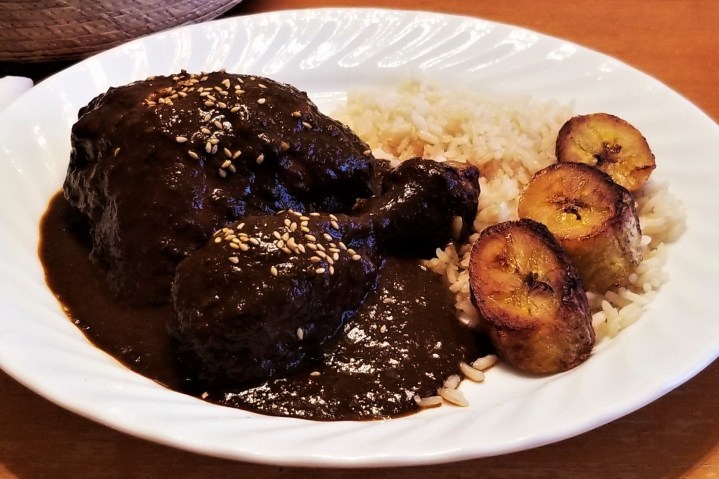
In Mexico, a turkey dinner with stuffing, baked pasta, and other side dishes, like the ones I have shared this month, are a popular choice for a Christmas menu, especially in urban areas. For others, though, stew-like dishes are usually the norm; two of the most traditional are “Revoltijo”, which literally translates as “jumble”, and “Bacalao navideño” – “Christmas Cod”. These are served both during the Lent/Easter and the Advent/Christmas seasons since the Advent season (the four Sundays before Christmas) used to be a time of contrition and reflection, similar to the Lenten season before Easter; for this reason, I posted my recipes for both dishes back in the spring (click on highlighted titles for full recipes and stories.)
Other Christmas favourites are of course tamales (with meat such as my Tabasco style Chanchamitos, or vegetarian, like my Layered Bean Tamales), and chicken or turkey in mole – an elaborate Mexican sauce. Continuing with recipes and traditions from Oaxaca, I am sharing one of the most emblematic of the many moles from that Mexican state: mole negro (Black Sauce). For moles in general, there are a few basic groups of ingredients, and each recipe will call for some in particular, depending on the flavours, colours and textures that are needed: peppers and fruit (fresh or dry, with different colours and textures), seeds, nuts, thickeners, and seasonings. I have posted my recipes for “Manchamanteles (literally “tablecloth stainer”, for its bright colour), and my homestyle red mole, which calls for dry red peppers, and chocolate, its most characteristic ingredient. Black mole has a similar ingredient list, but chosen to impart a dark colour to the sauce, such as dark dry peppers, and peanuts with their dark film on, as well as a good portion of chocolate; the guile of regional cooks also shows with perplexing techniques, such as purposely burning some of the ingredients. The resulting flavour profile is smoky, deep and slightly sweet.
Oaxaca Style Black Sauce – Mole negro estilo Oaxaca
Ingredients (for 8 portions)
10 dry dark peppers, such as a combination of mulato, black pasilla, and black chilhuacle (See **NOTE)
½ onion; peeled and sliced into two pieces
3 cloves garlic; peeled
1 tomato; washed
2 avocado leaves, or omit, if not available
1 plantain
¼ tablet (approx. 28 g, 1 oz) Mexican chocolate (such as Ibarra™ or Abuelita™)
1 slice bread
1 corn tortilla
½ tsp dry oregano, preferably Mexican
½ tsp dry marjoram
½ tsp dry thyme
1 bay leaf
¼ stick Mexican cinnamon (or ½ tsp ground cinnamon; see *Important note)
¼ tsp ground all-spice
¼ tsp ground cloves
½ tsp ground black pepper
Pinch anise seed
2 tbsp peanuts; out of the shell but with dark film on
4 tbsp nuts (almonds, walnuts or half of each)
2 tbsp sesame seed
2 tbsp raisins
Vegetable oil or lard
3 cups chicken broth, or water, as needed
2 tbsp sugar, or to taste
Salt, to taste
I was able to find mulato (wide peppers in the photo below), and black pasilla peppers (narrow peppers); I used 6 mulatos and 4 pasillas. Wipe peppers clean with a damp towel; remove and discard stems; remove seeds and save about two tablespoons:
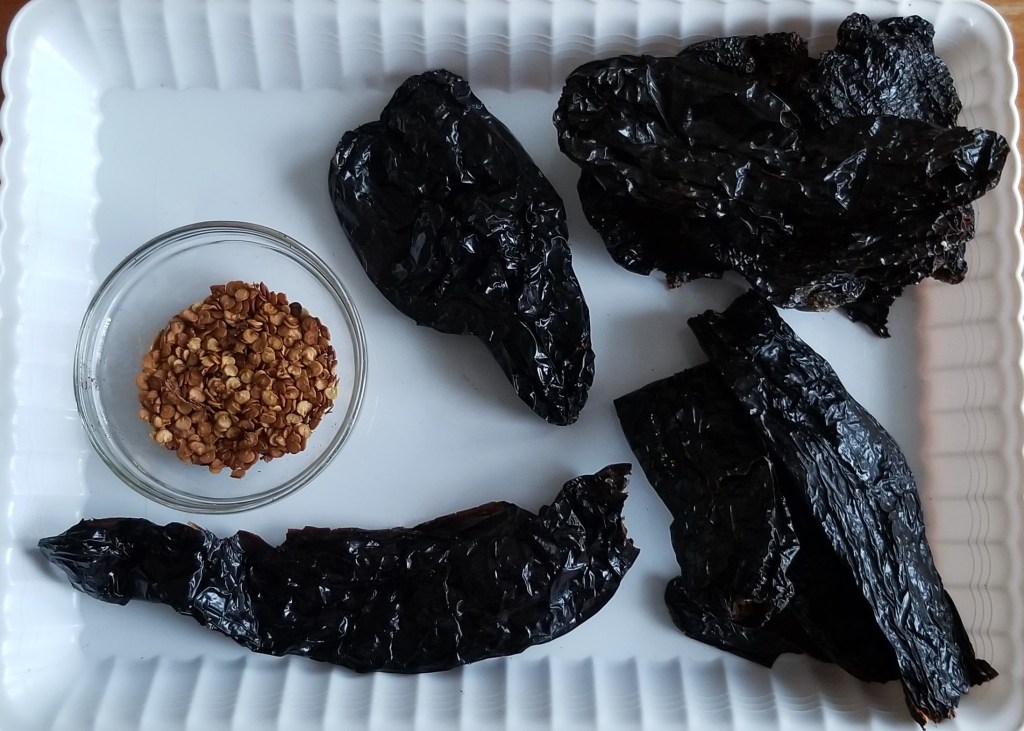
Roast peppers on a dry skillet (no oil) over medium heat, turning frequently and being careful not to burn them, but long enough that they swell and become crispy (photo below, left); work in batches, transferring the roasted peppers to a large bowl. At the end, add reserved seed to the skillet, stirring to toast them evenly (photo below, right):
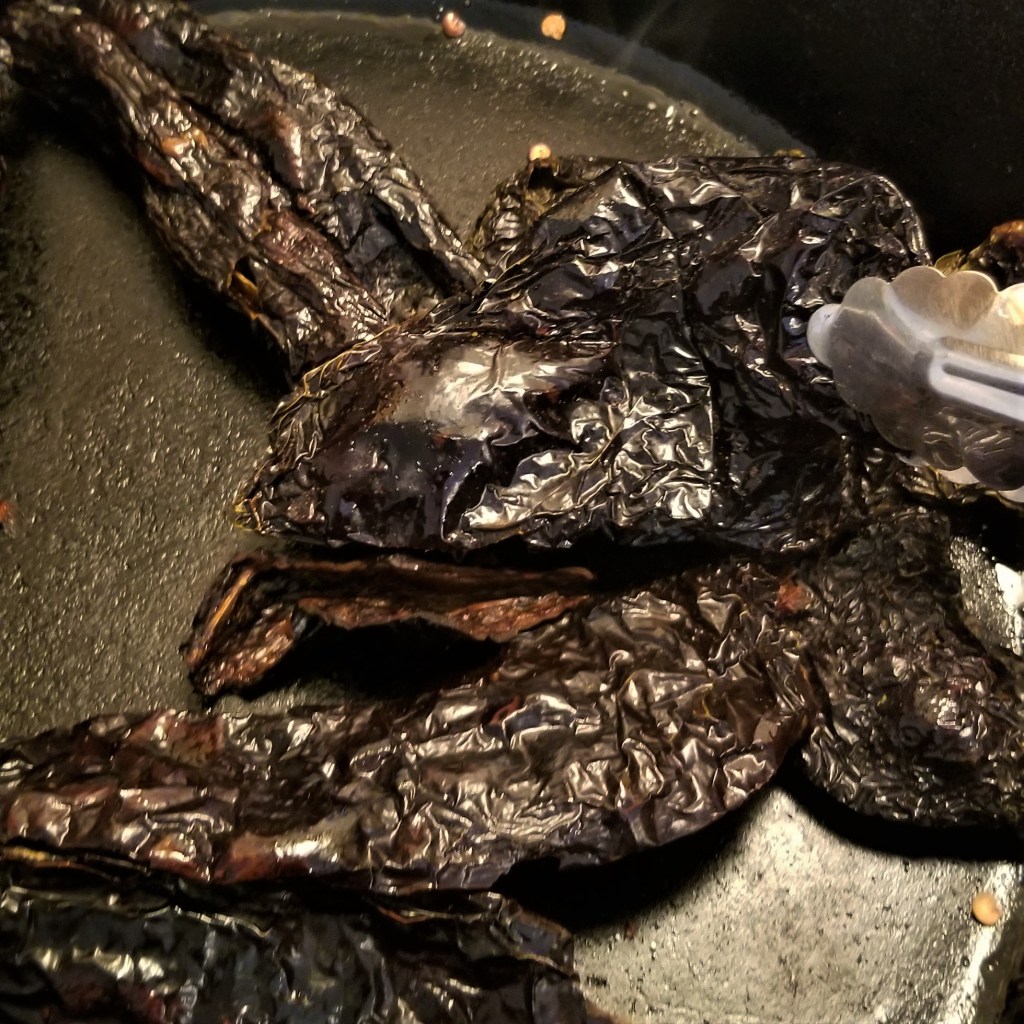
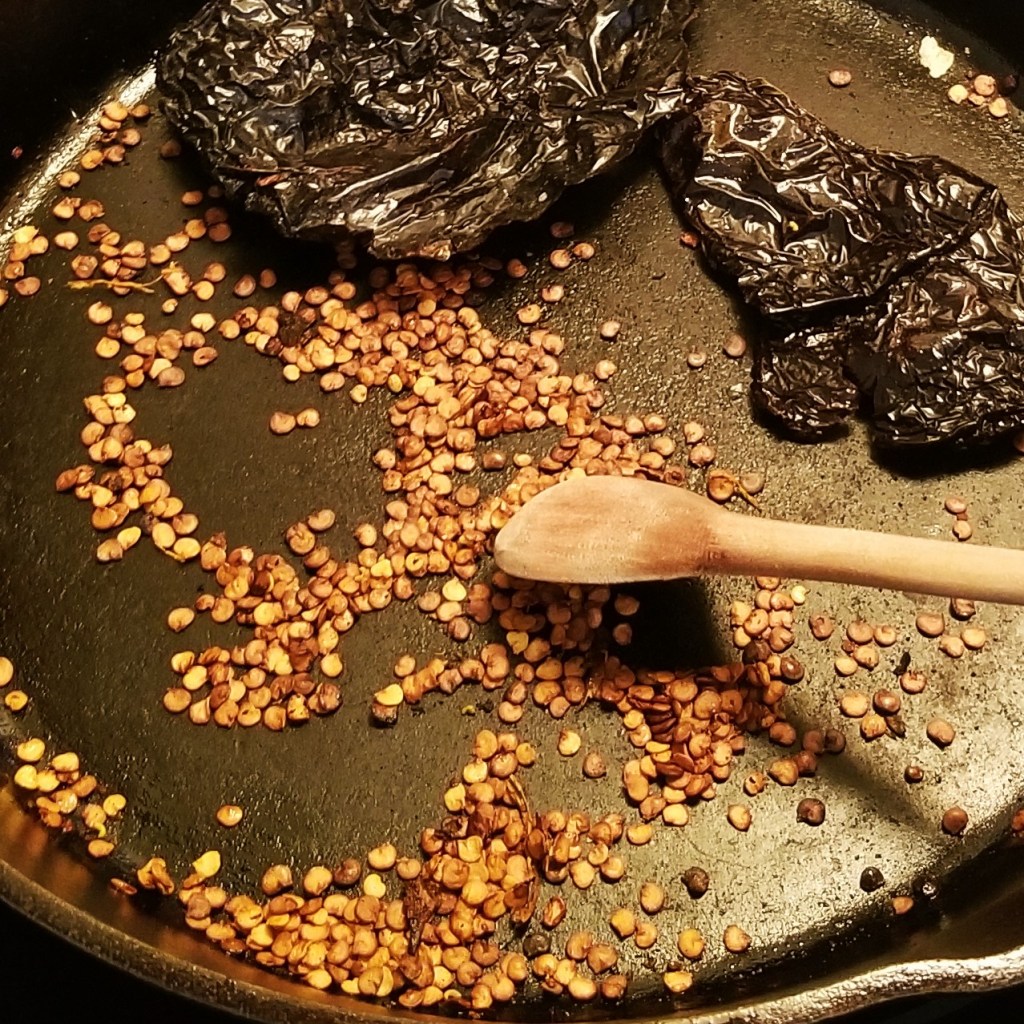
It is fine to toast the seeds until slightly burnt; transfer them to a separate bowl:

Toast corn tortilla in the skillet or a toaster oven, carefully burning it as dark as possible. Add to the bowl with toasted seed (photo below, left), breaking into pieces and crumbling (photo below, right):
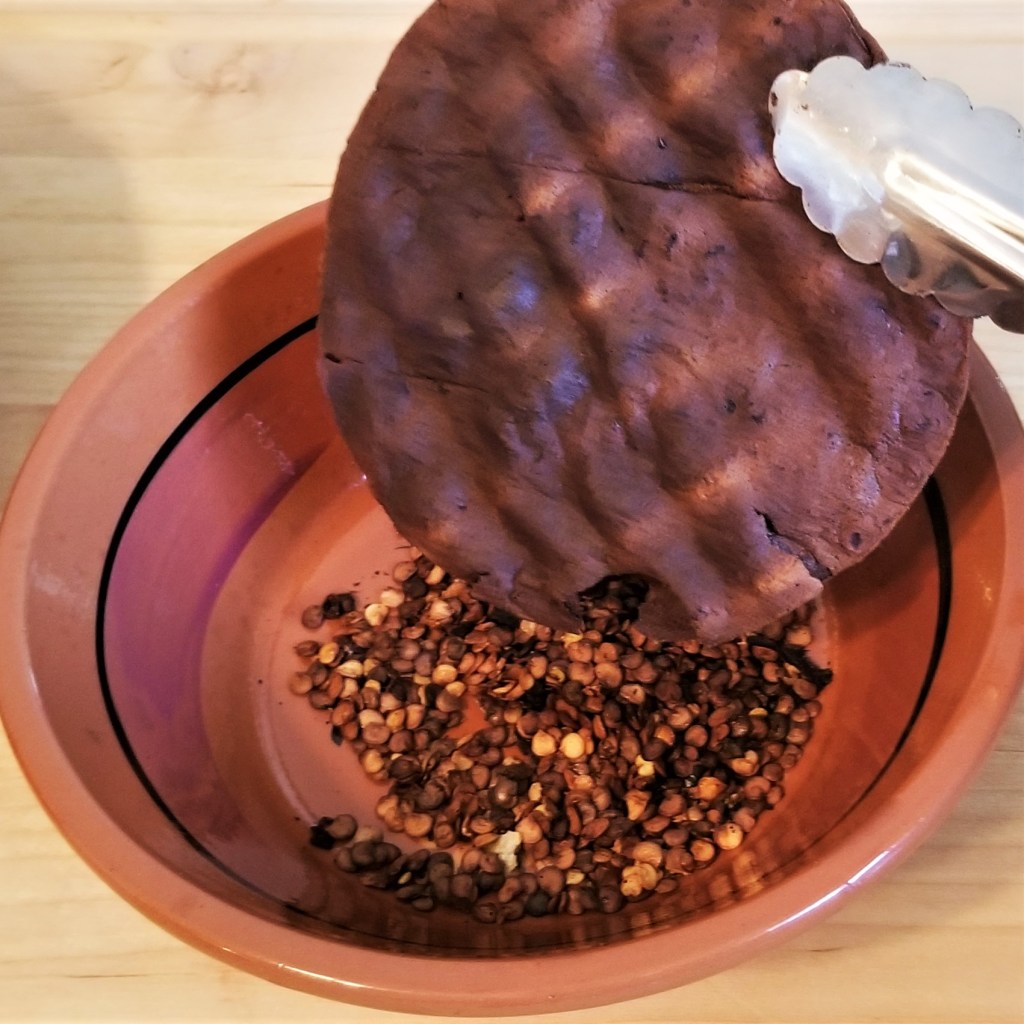
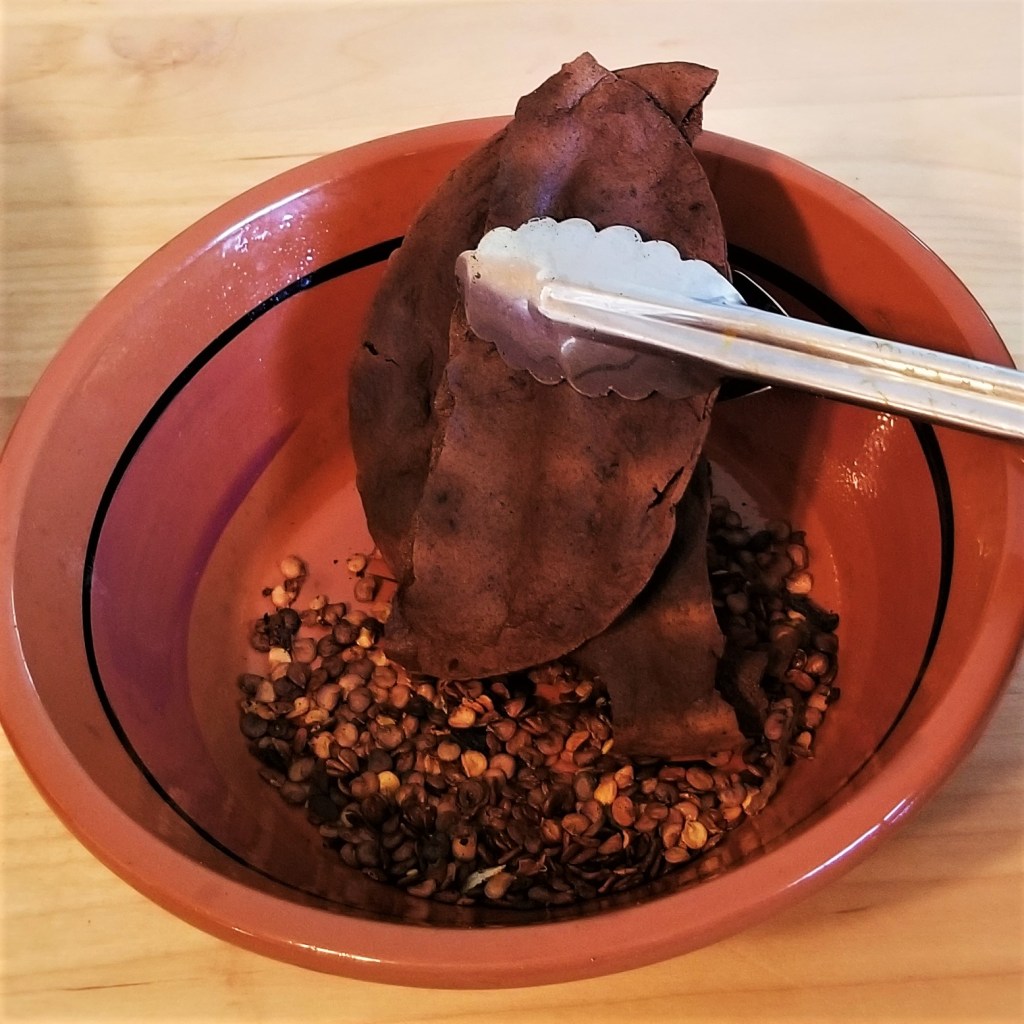
Measure herbs and spices. The dry herbs (oregano, thyme and marjoram) should be well packed while measuring. *Important note: The cinnamon must be Mexican (Ceylon cinnamon) if used as a stick (as shown below); otherwise use ground cinnamon, as other sticks (such as cassia cinnamon) would be next to impossible to grind later on, or might damage the blender blades:
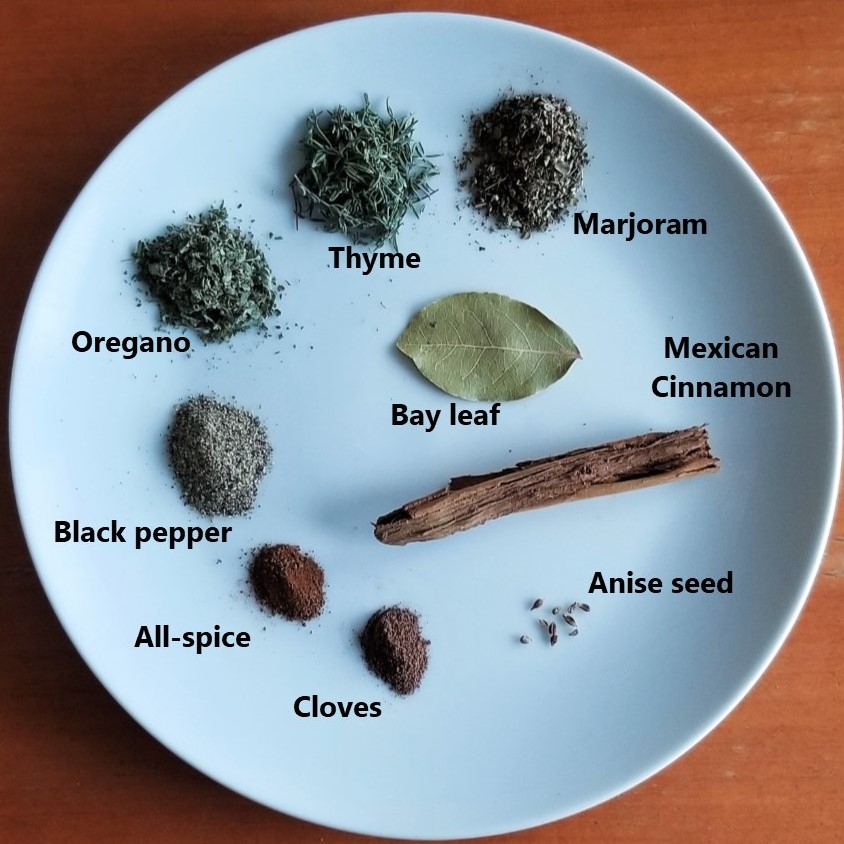
Dry roast all the spices and herbs in the skillet (I added the avocado leaves, as well, photo below, left); stir and turn just until they become fragrant, then transfer to the bowl with the seed and burnt tortilla crumbs (photo below, right):
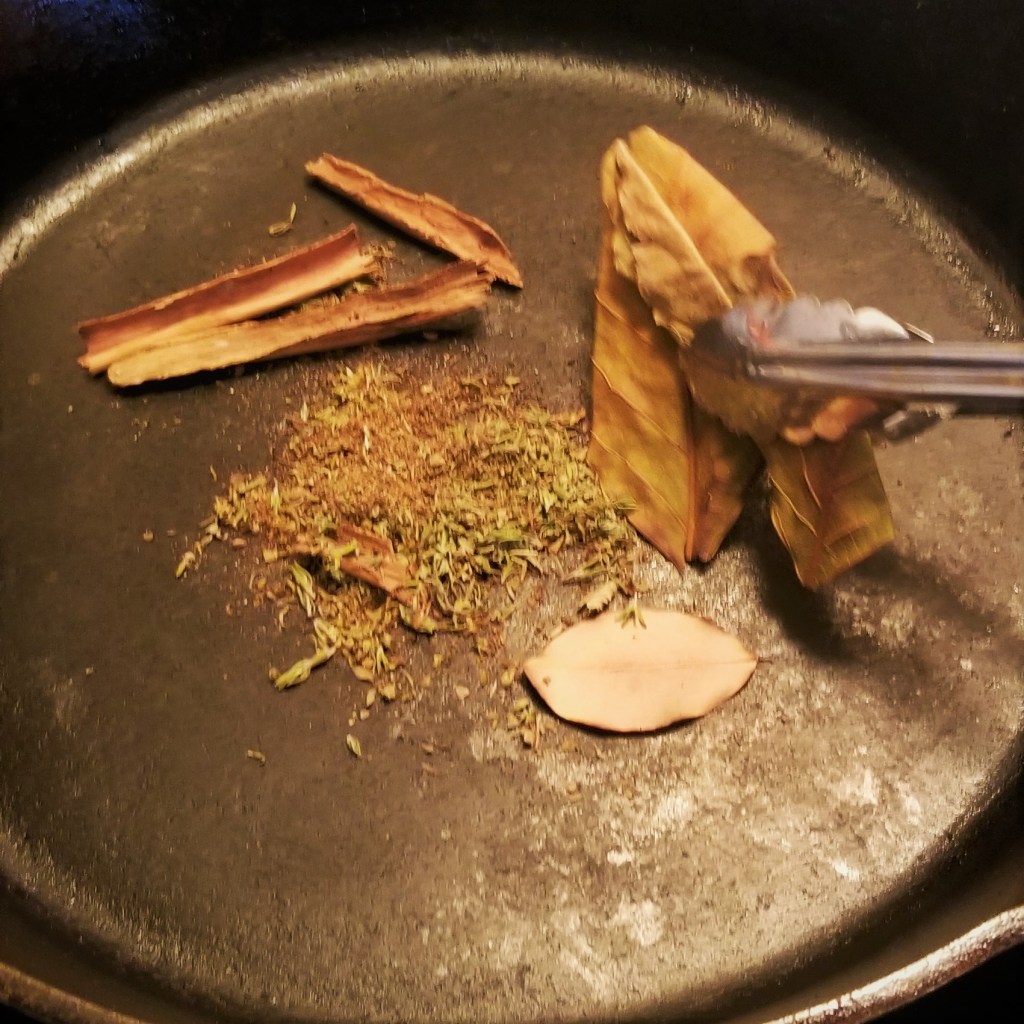
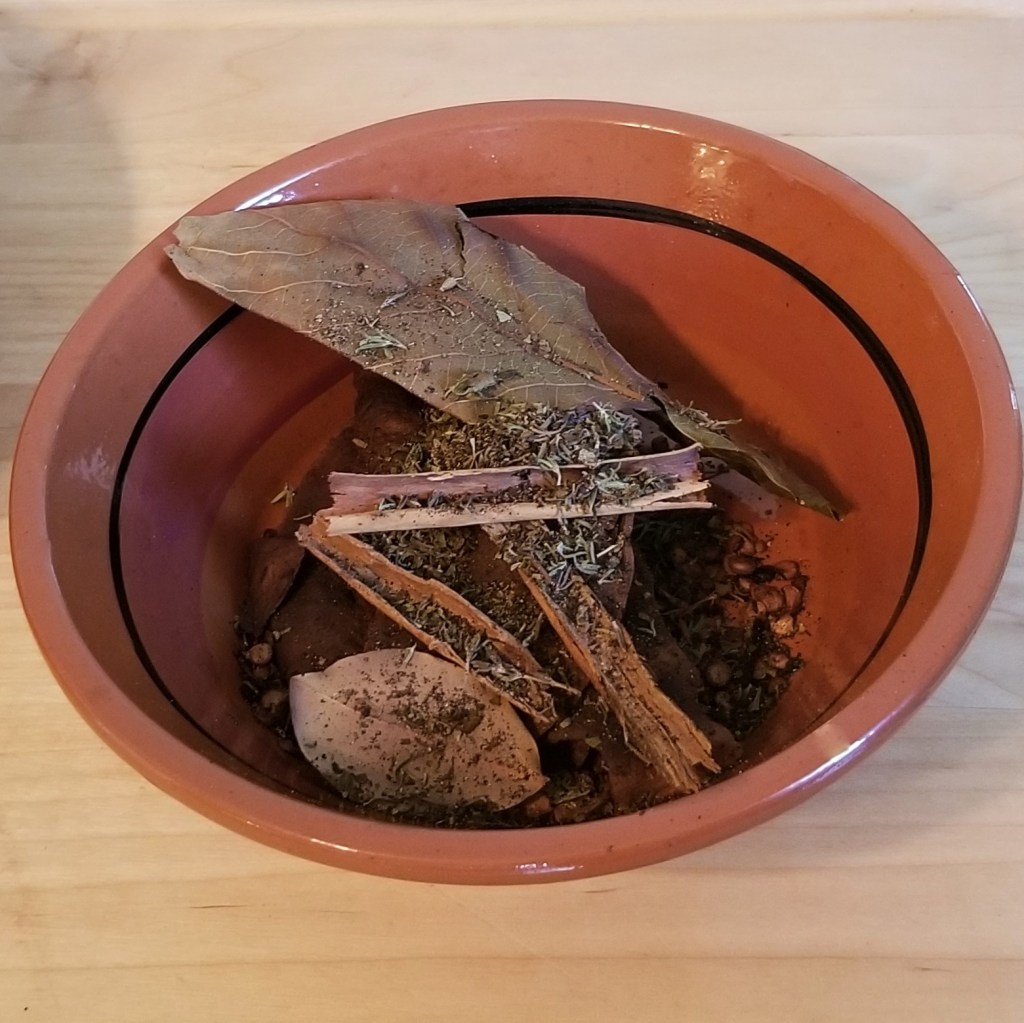
Dry roast the tomato, onion and garlic in the skillet (photo below, left). For these vegetables, a well charred (tatemado) finish is wanted. Transfer half the onion and two cloves of garlic to the large bowl (photo below, right):
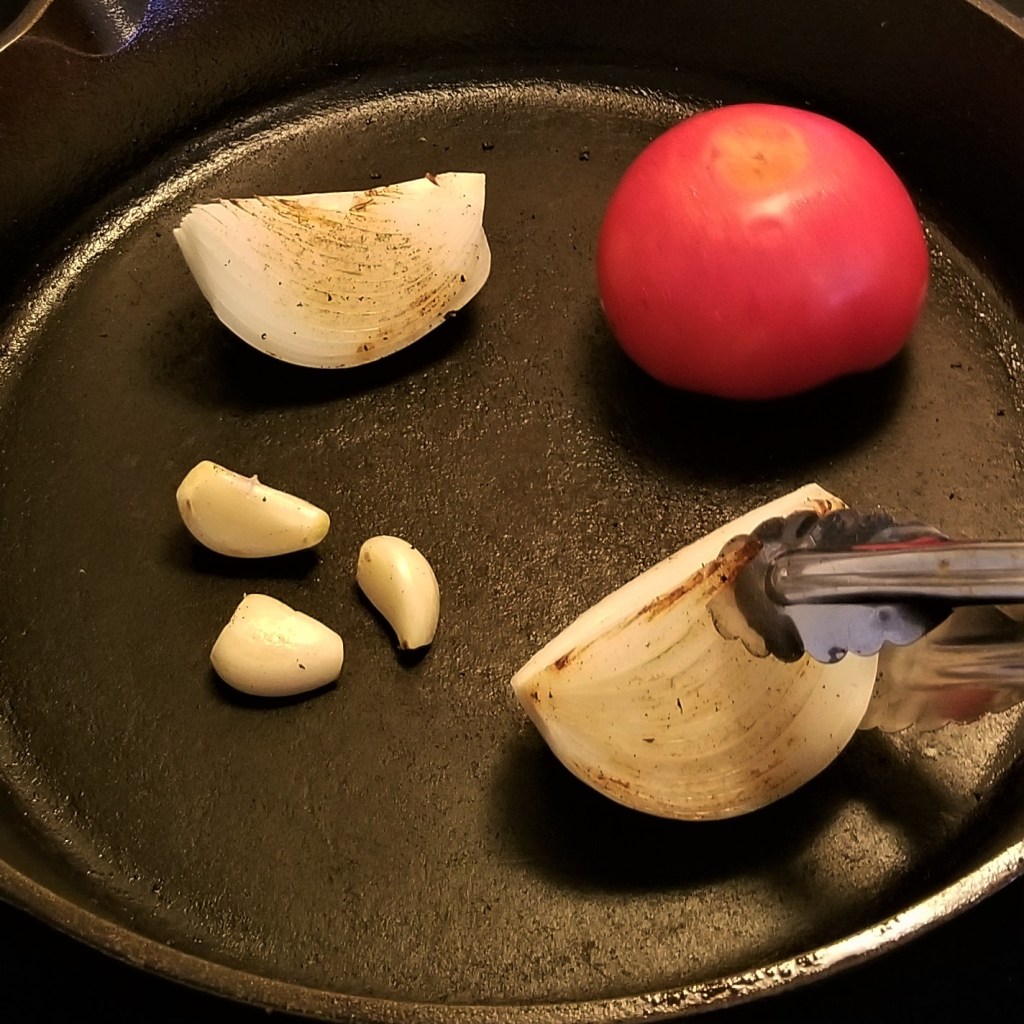
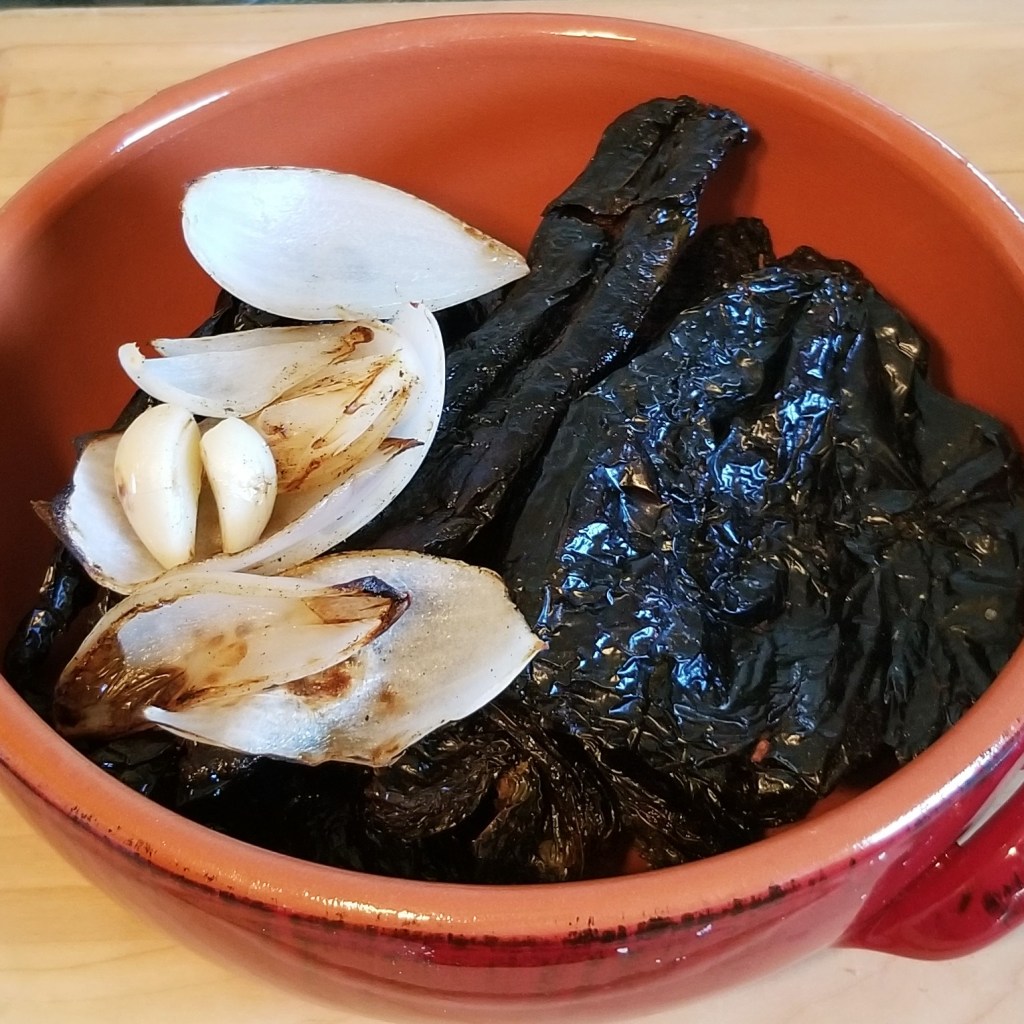
Remove stem end from tomato, slice into chunks and transfer to a blender jar, along with any juices from it; add the resto of the onion and the last clove of garlic (photo below, left). Blend thoroughly into a smooth sauce (photo below, right):
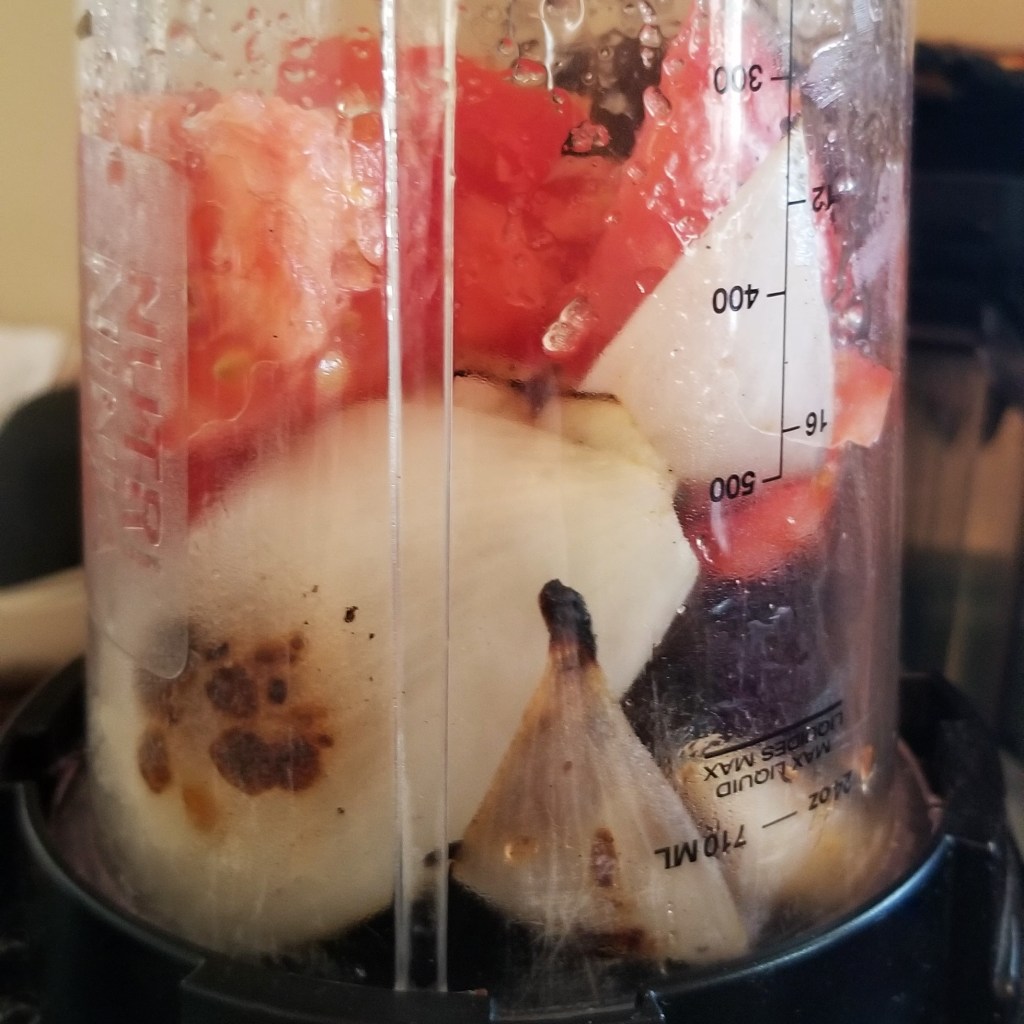
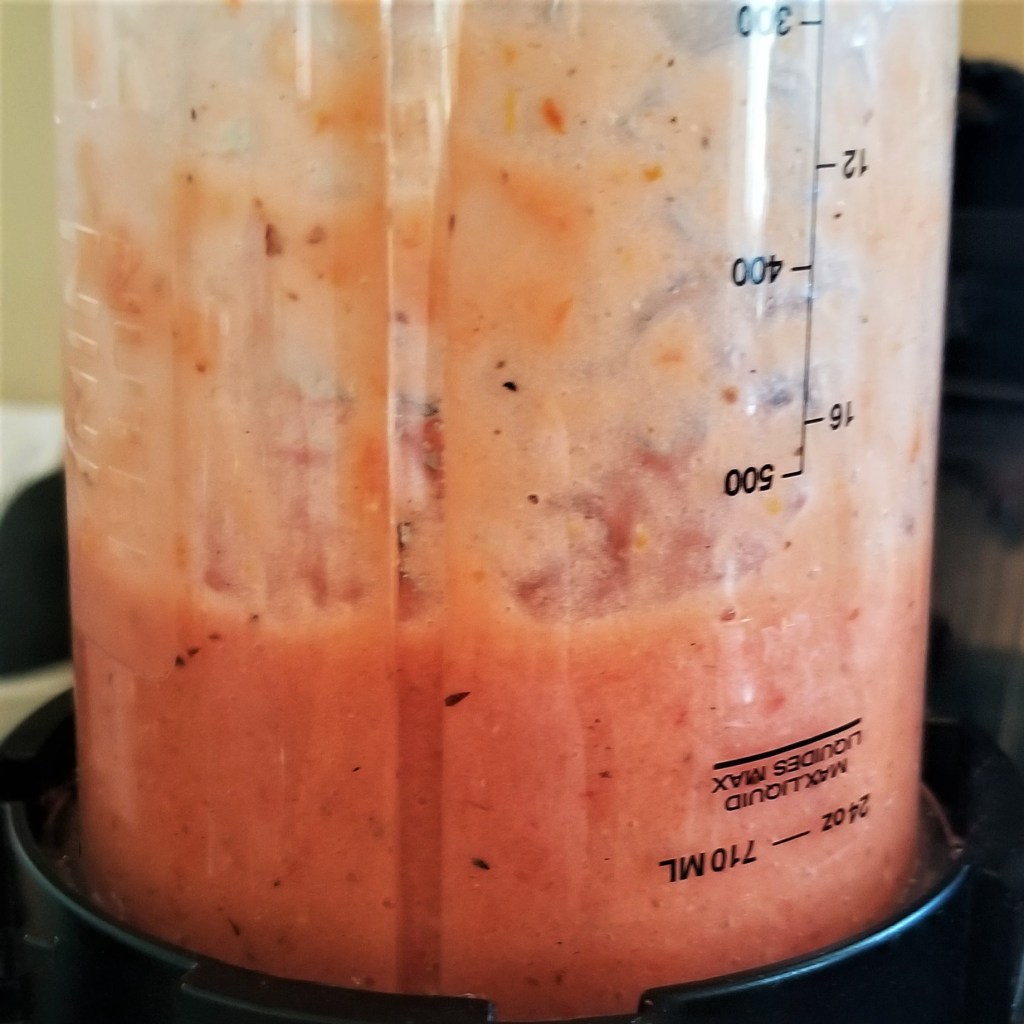
Reserve sauce. Wash plantain and slice in half; peel and slice one half, and reserve the other half. Toast bread and slice into chunks. Gather peanuts, nuts (raw almonds and walnut chunks in the photo below), sesame seeds and raisins:
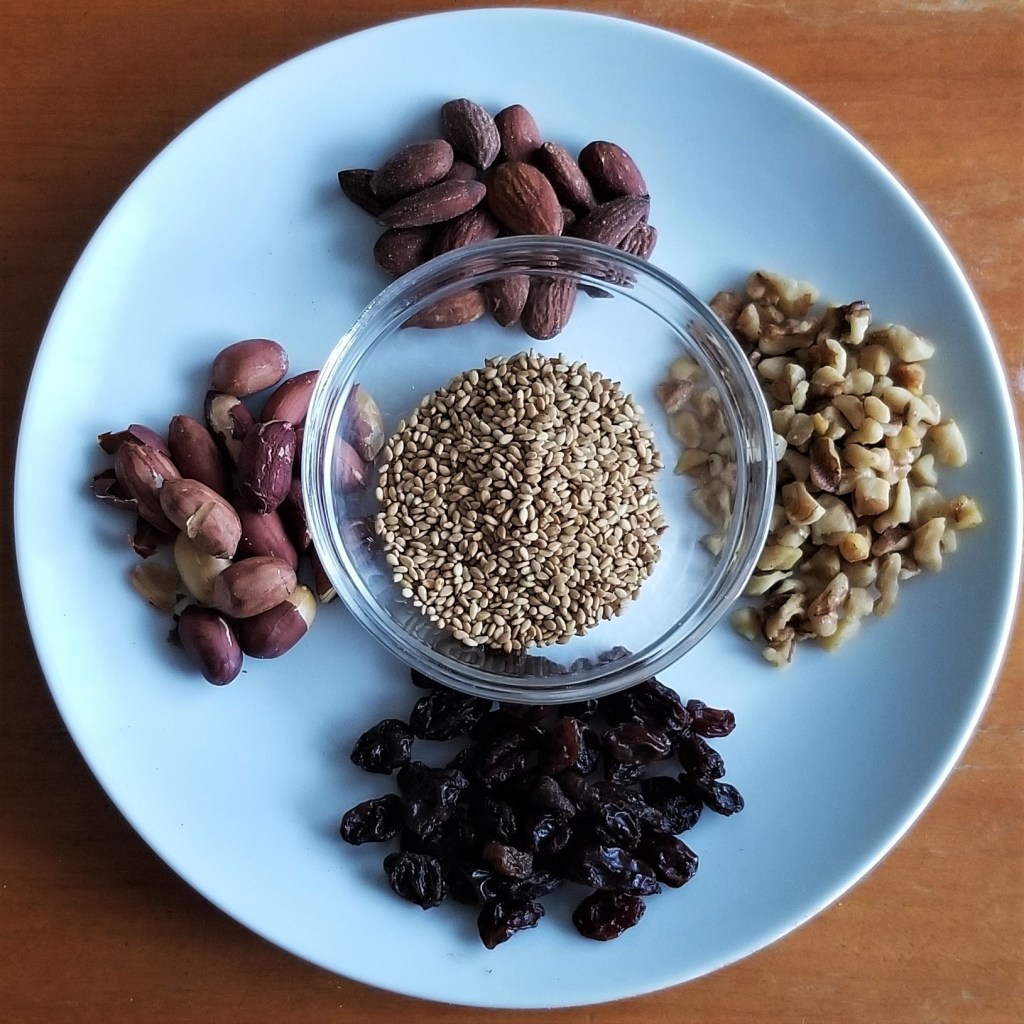
In a large pan, add two tablespoons of lard (or vegetable oil), and warm up over medium heat. Add almonds, walnuts and peanuts, stirring and frying for about two minutes: add plantain slices (photo below, left). Continue cooking, flipping the plantain as the slices turn golden brown. Add bread, raisins and sesame seeds, stirring constantly until everything is toasted and has turned dark, and the sesame seeds start to pop (photo below, right):
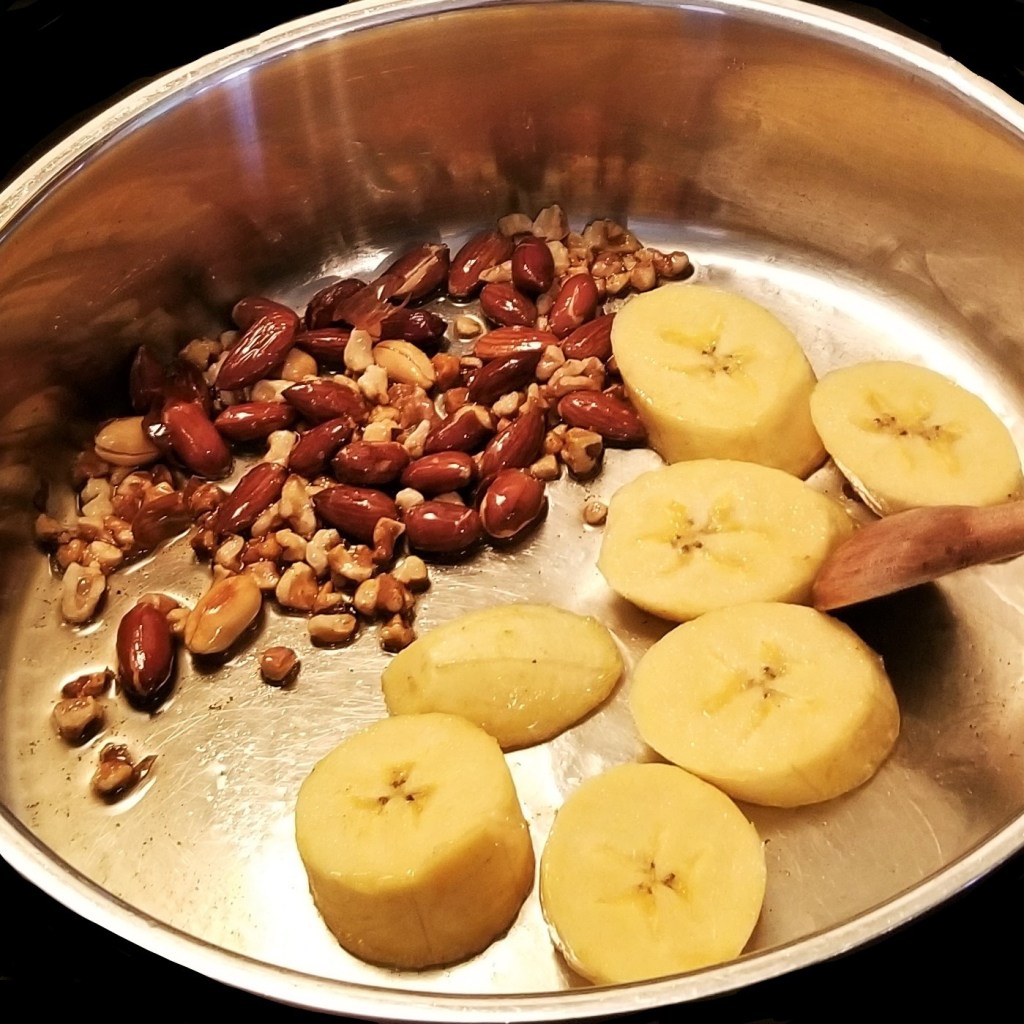
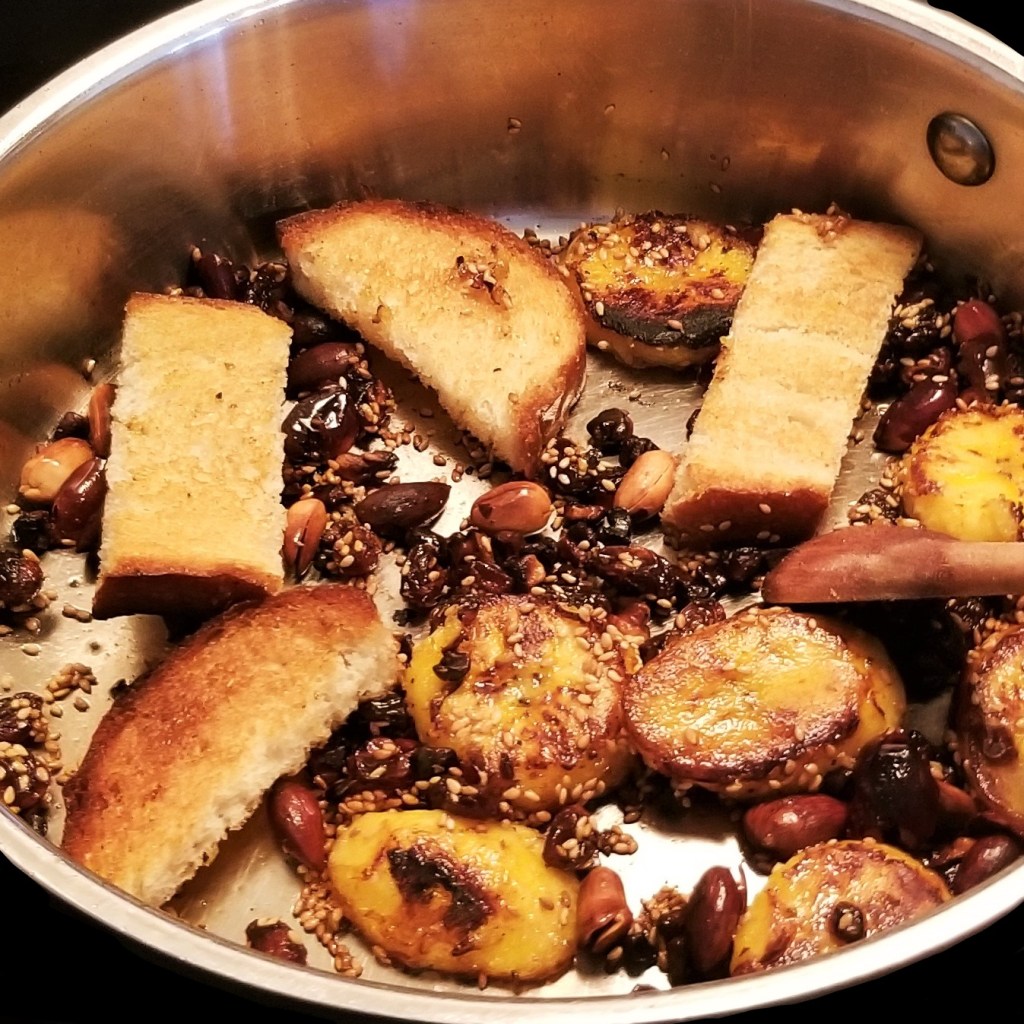
Add reserved ingredients from the large bowl, and one cup of broth, or water (photo below, left). Bring to a boil, then reduce to a simmer, cooking and stirring until bread and peppers have wilted (photo below, right):
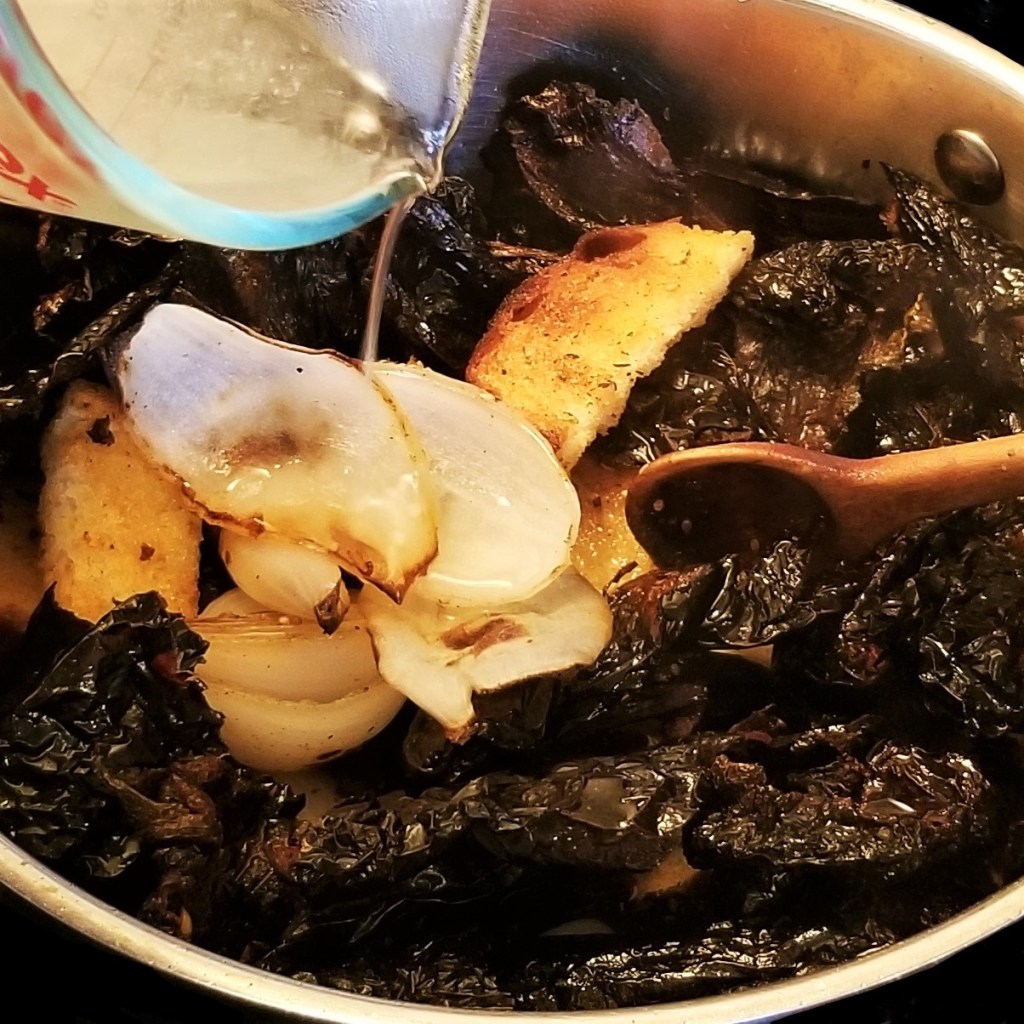
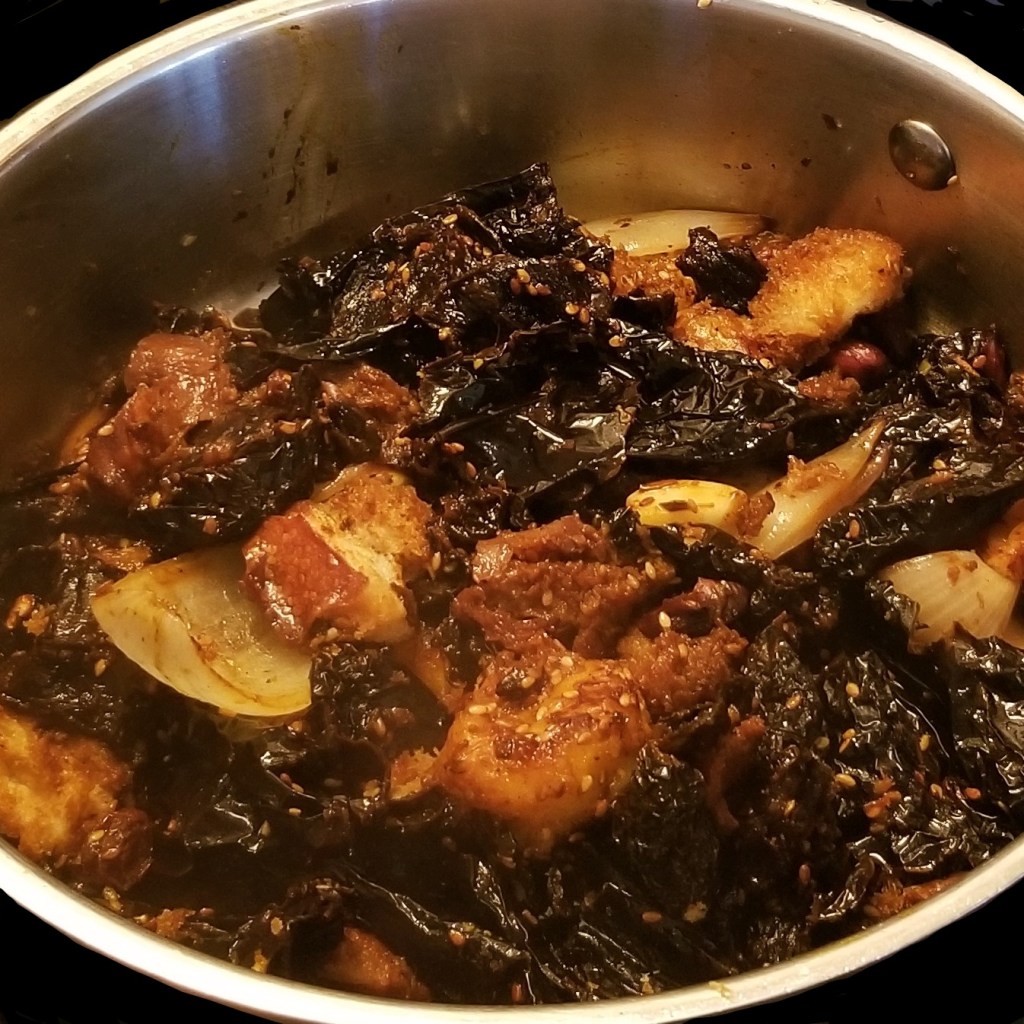
Meanwhile, place all the ingredients in the bowl with the pepper seeds in a mortar or blender jar; add a little liquid (broth or water, about a quarter of a cup), and process with pestle by hand, or at high speed in the blender, until a smooth paste is formed (photo below, left). Add all the contents from the pan (photo below, centre), and grind or process until a very smooth paste is obtained (photo below, right):
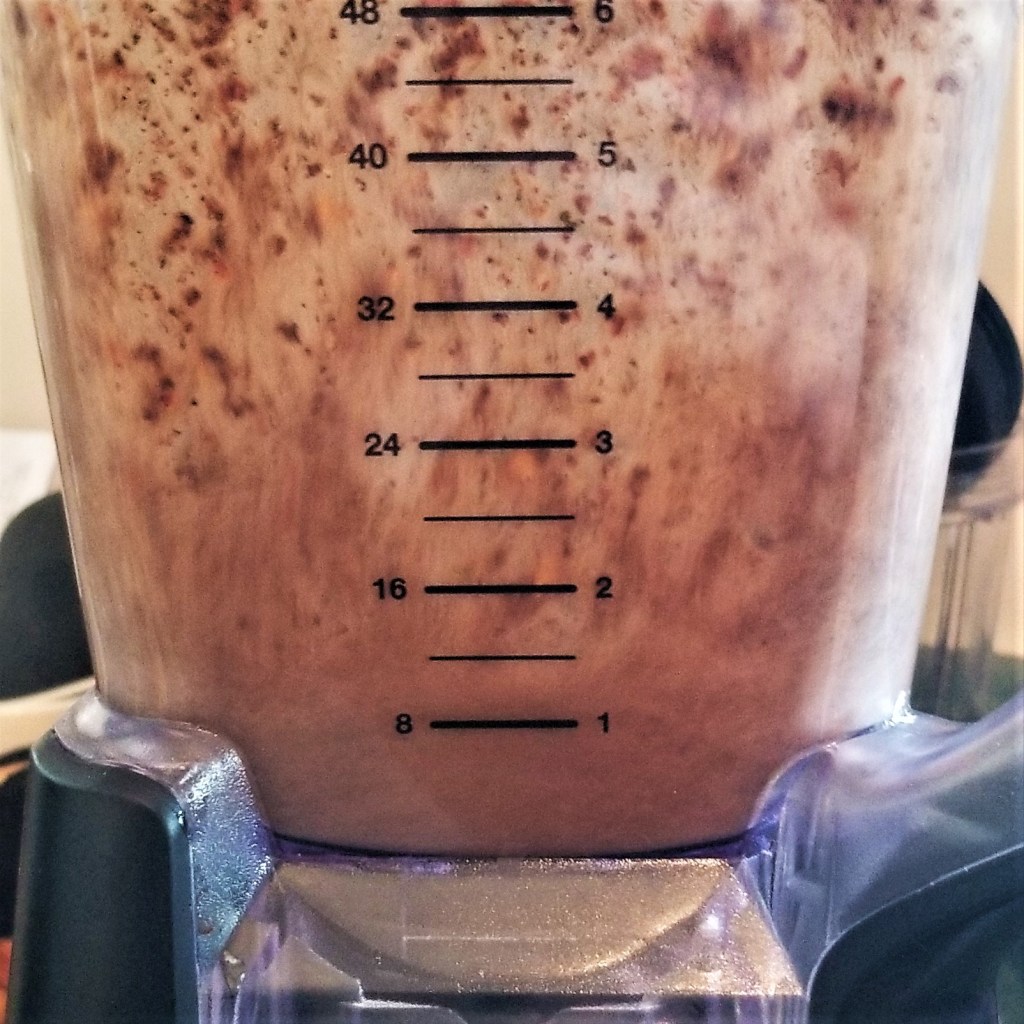

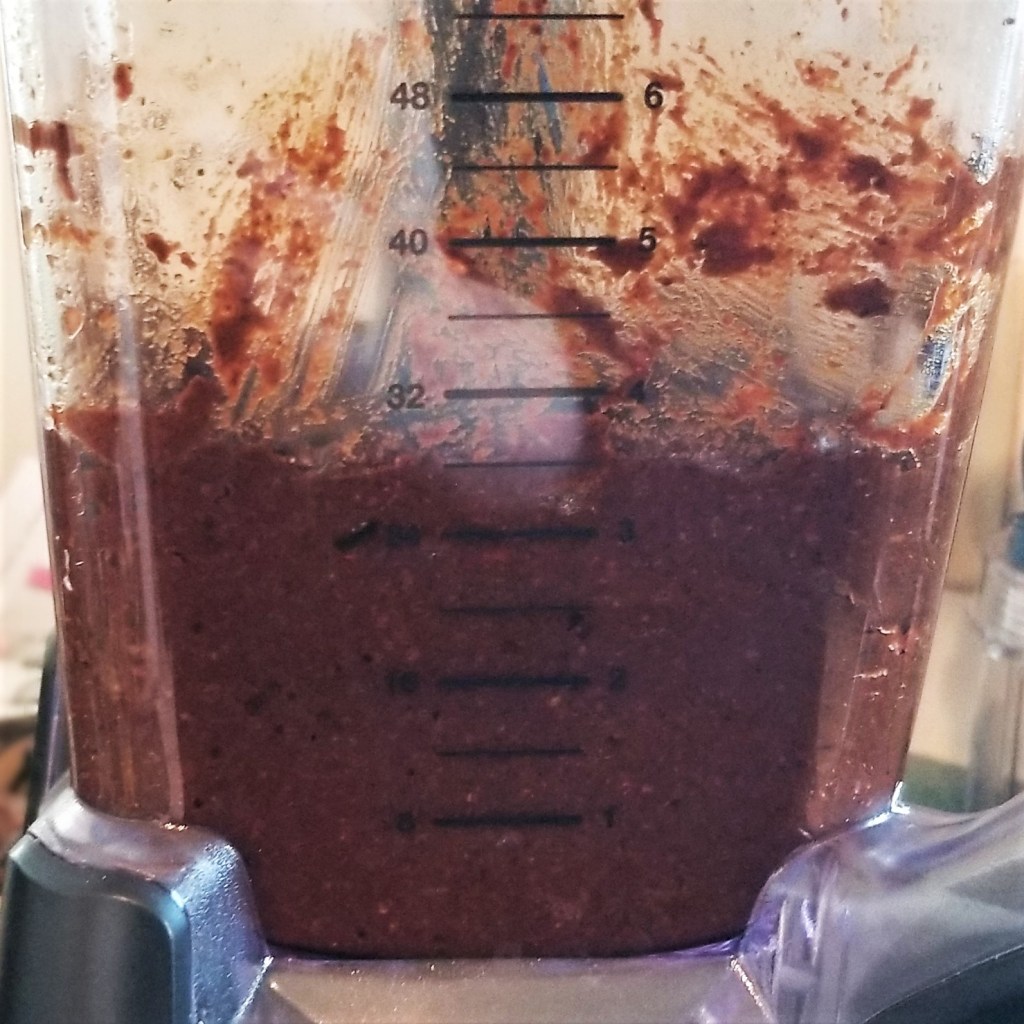
Back in the pan, add two more tablespoons of lard (or oil); warm up over medium heat then add the paste. Cook the paste, stirring constantly to avoid burning (photo below, left); continue for at least twenty minutes, and until the paste turns dark and does not stick to the pan anymore. Add salt (I added half a teaspoon) and chocolate (photo below, right):
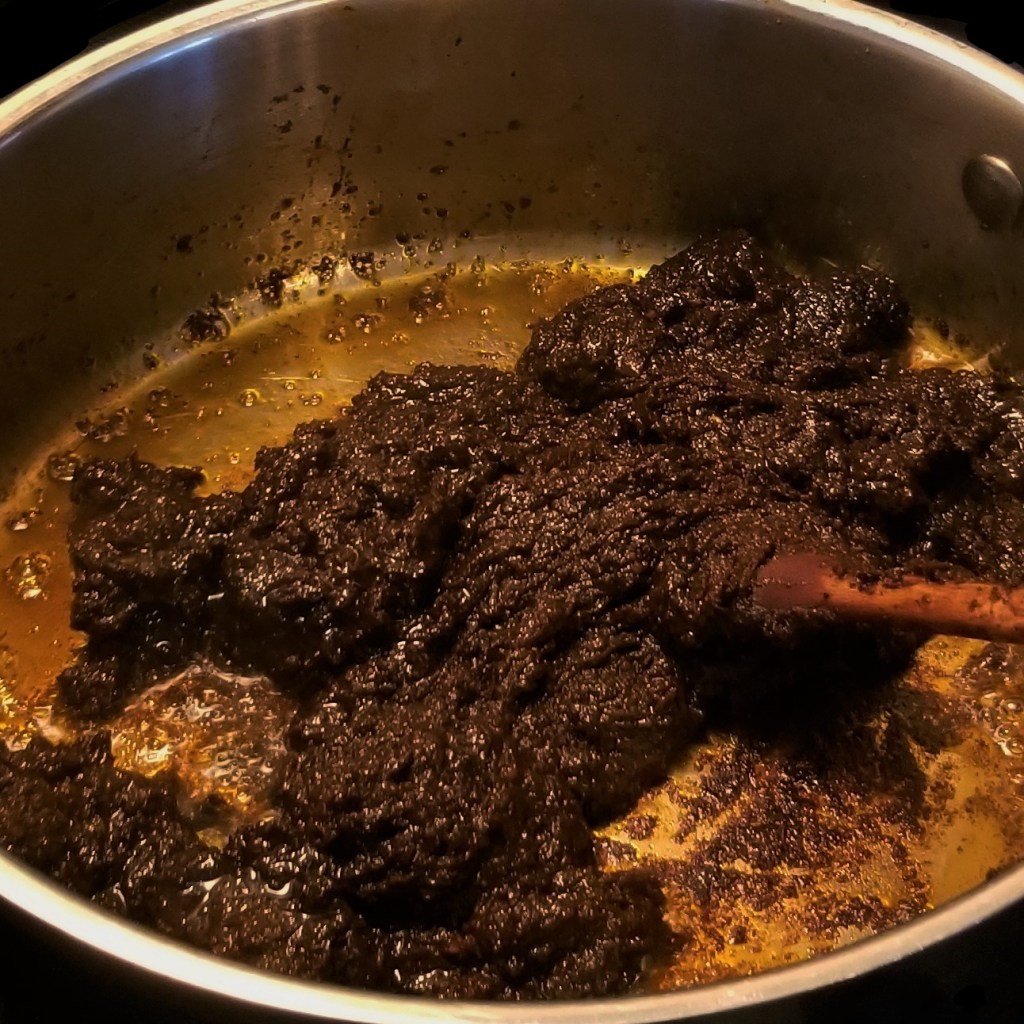
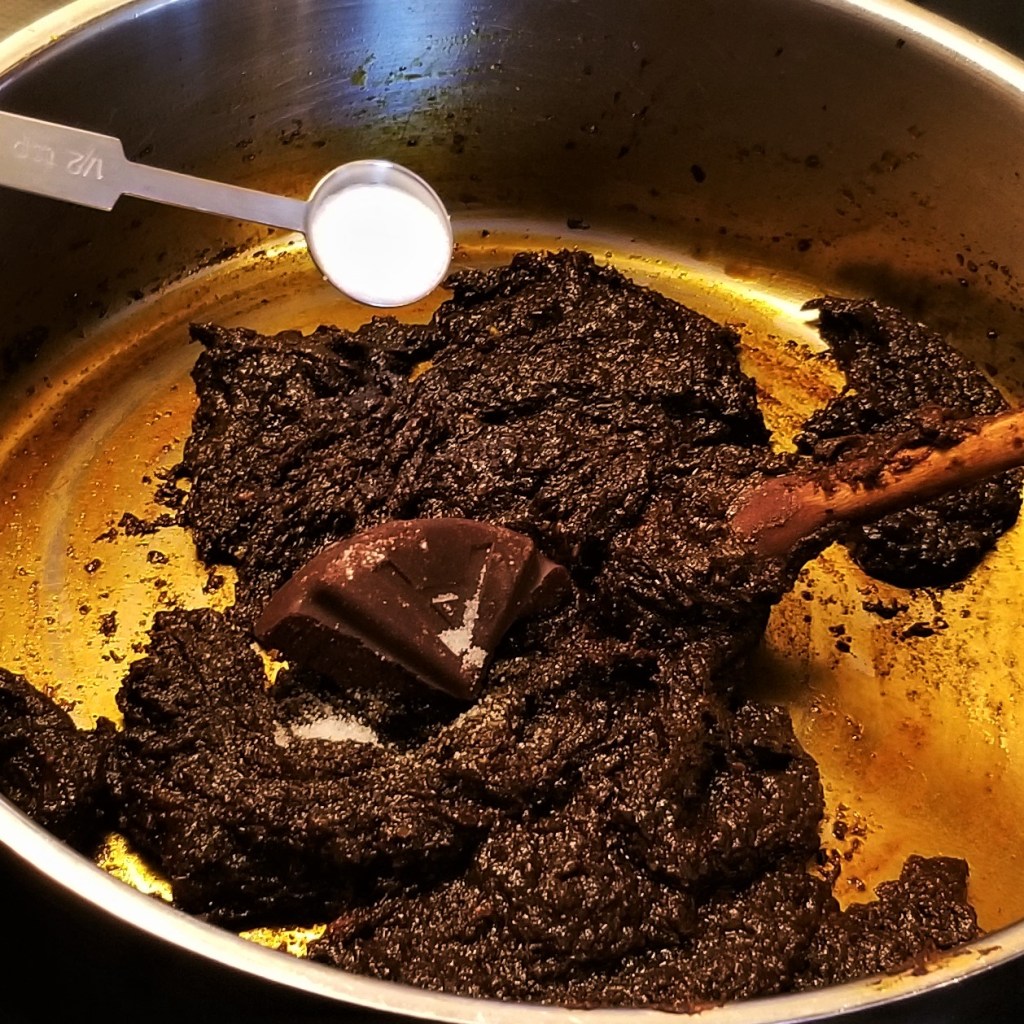
Stir until well dissolved, then add sugar, and continue stirring to dissolve, as well. Pour in reserved tomato sauce (photo below, left). Gradually add another cup of broth (or water), stirring to incorporate. Continue cooking to form a smooth paste, about ten more minutes. Correct seasoning with more salt or sugar, to taste (I added another half teaspoon of salt, photo below, right):
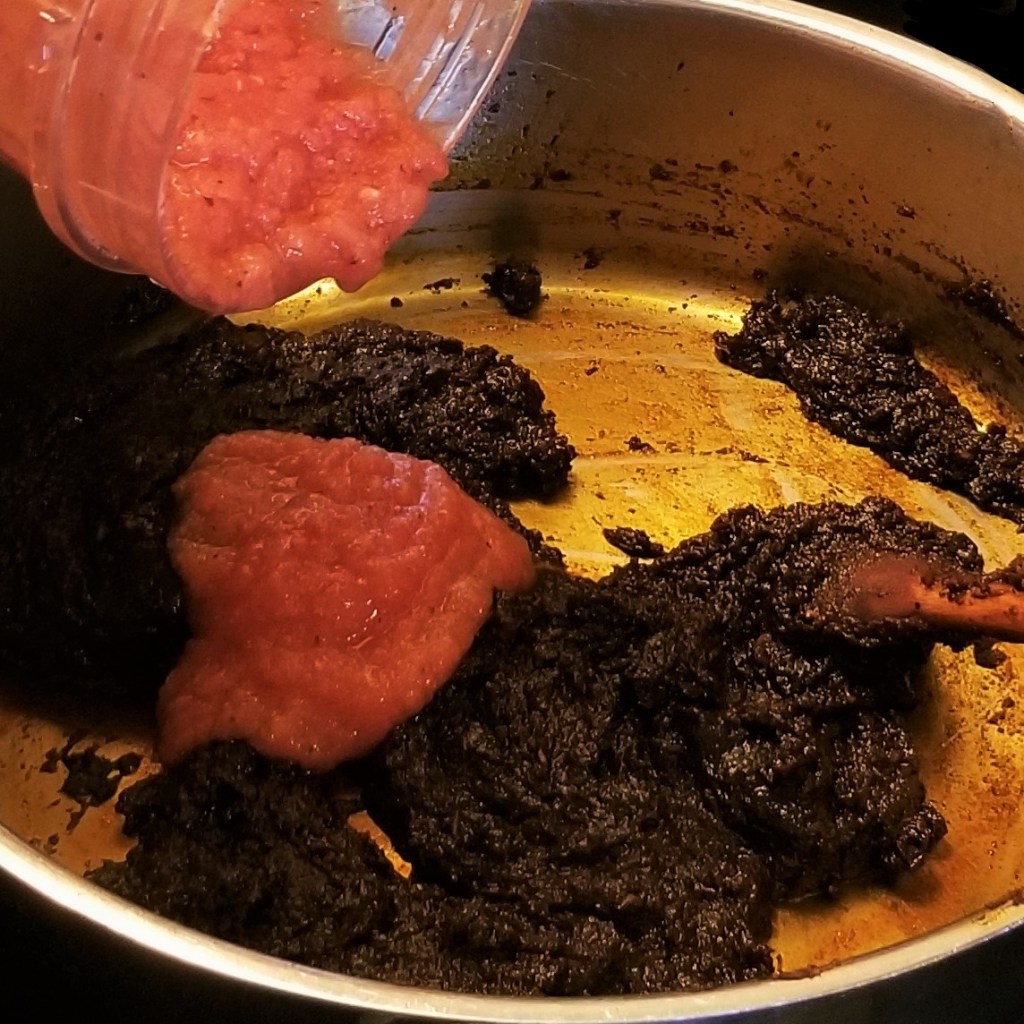
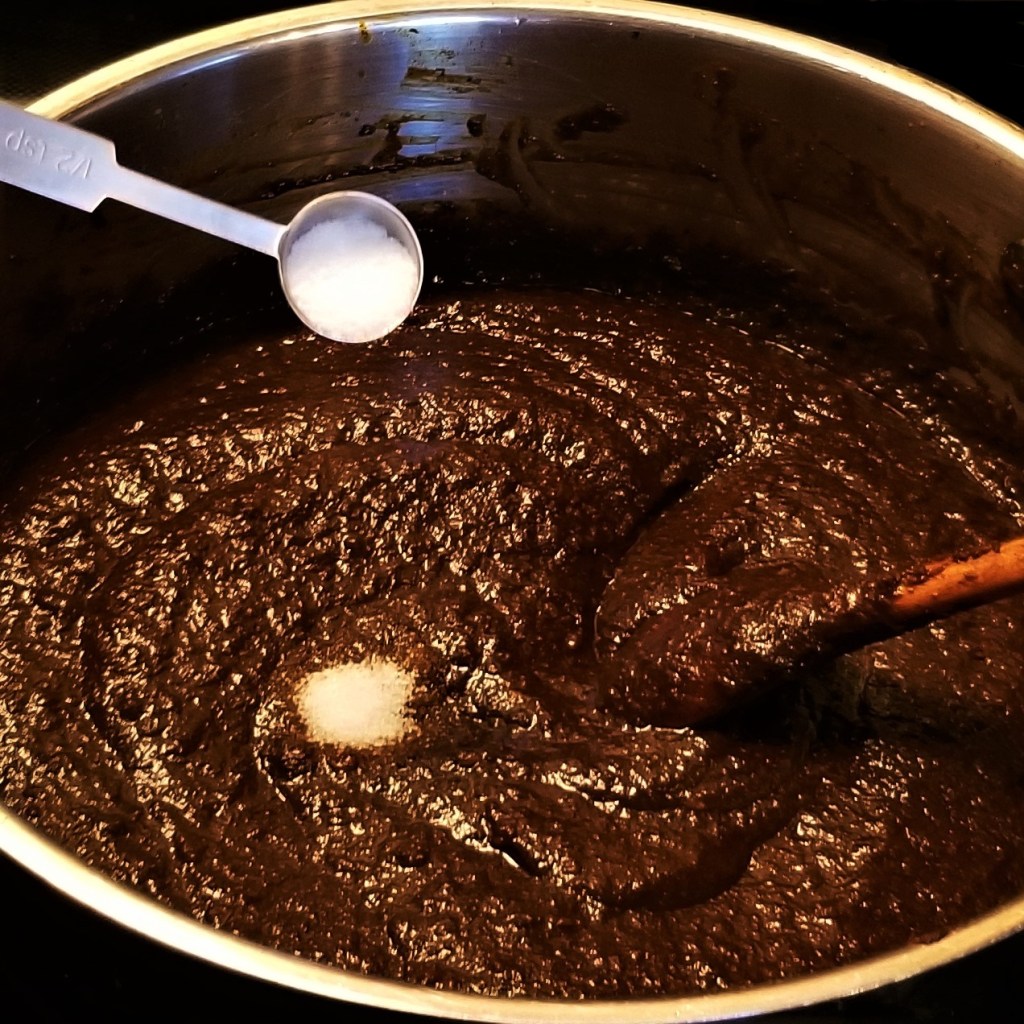
This paste may be cooled down to room temperature, packed in freezer bags and kept in the freezer for up to three months. 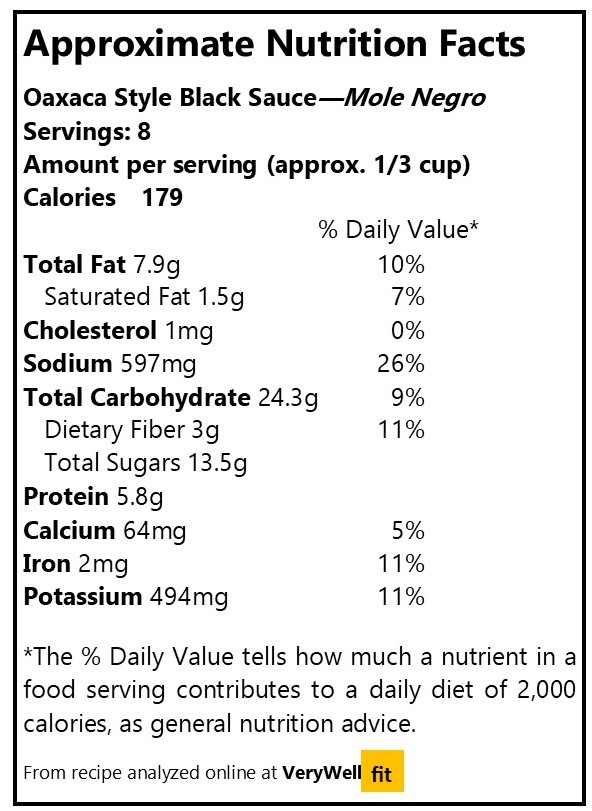
If preparing for a meal, add more liquid, as needed, to achieve the consistency of a thick sauce. The classic way to serve this mole negro in Oaxaca is with bone-in pieces of cooked chicken, covered with a generous portion of mole, a side of Mexican Style White Rice, and fried plantain slices (the reserved half from the recipe may be used here). Finish by sprinkling some toasted sesame seeds on the mole, and serve with warm corn tortillas:
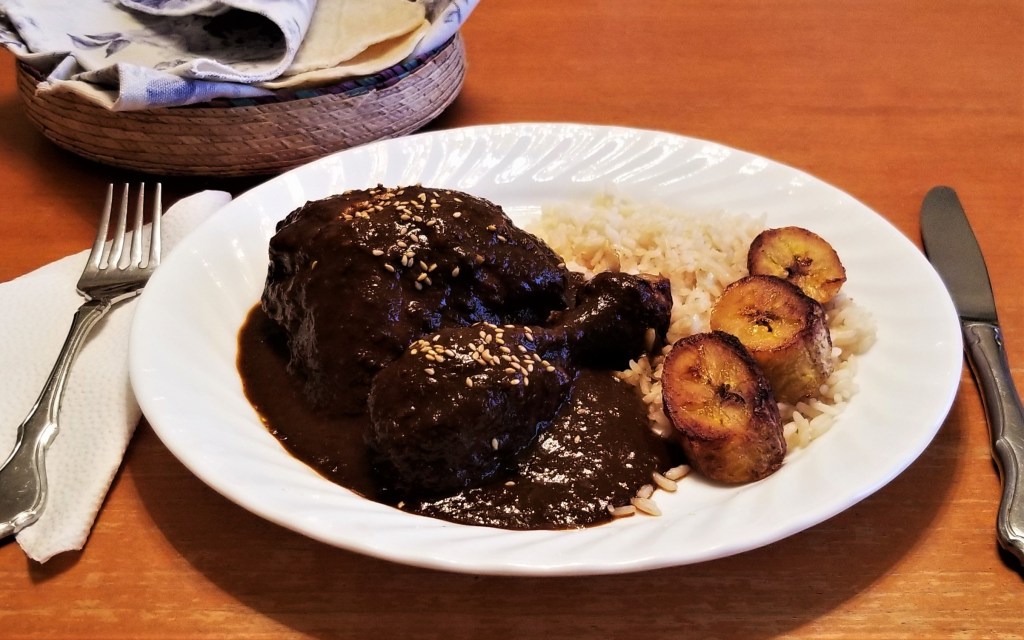
Many Mexican families have their largest gatherings on Christmas Eve; after a late church service, there is the comfort of a generous dinner, and plenty of joy when presents are opened afterwards. On Christmas Day or subsequent days, relatives and friends may drop by, and get together more casually to partake of “el recalentado” which means “the re-heated”, referring to the leftovers from the Christmas feast. This mole is great as a leftover meal; when re-heated, as with many stews, the flavours intensify and mature. For a vegetarian option: Having used water instead of broth, and vegetable oil over lard for the mole, skip the chicken and serve covering roasted vegetables (such as potatoes, sunchokes or parsnips), along with rice and plantain as before. Leftover mole might also be used in other dishes, such as enchiladas. They may be filled with leftover shredded chicken, or, in a unique style traditional in Oaxaca, for another vegetarian option, fill the warm corn tortillas with cooked and smashed potatoes and grated cheese, then roll and cover with a generous portion of black mole and top with onions and more cheese:
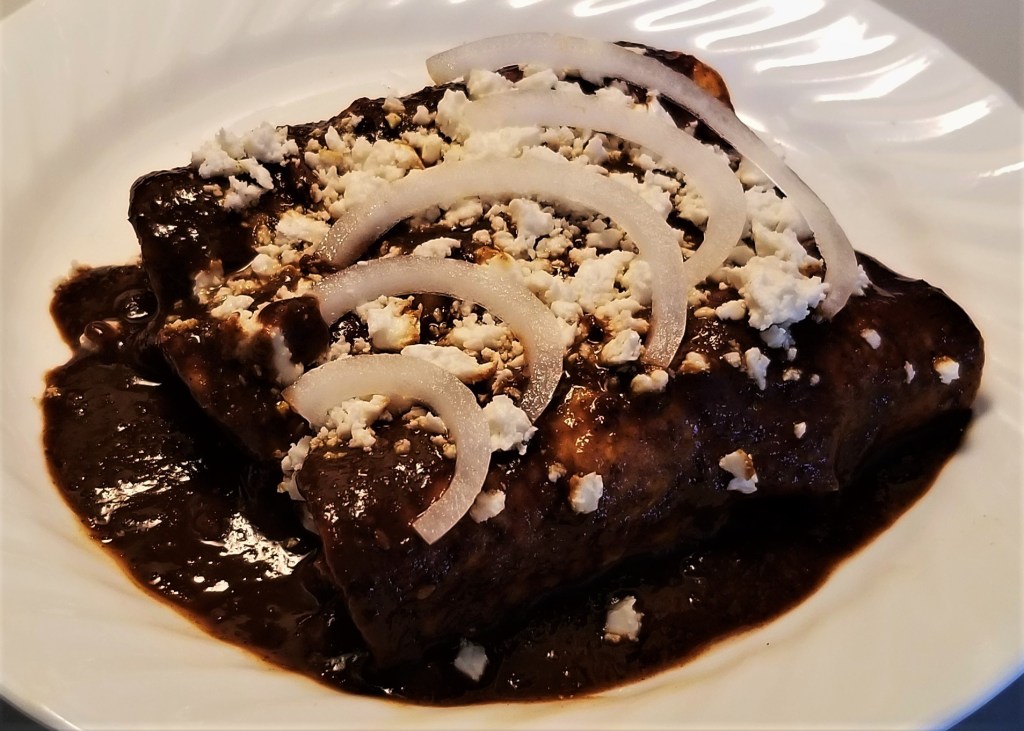
** NOTE – About the peppers: In Oaxaca, there are yellow, red and black chilhuacle peppers, but they are varieties very hard to find elsewhere; the only source I found online was for seeds (maybe I will try to grow my own one day). For your convenience, click on the images below for products available on Amazon™ :
DISCLAIMER: Any reviews included in this post are my own, for items I have purchased, not provided by any company; as an Amazon Associates Program affiliate, I might receive a commission for any purchases originated from the links below, at no extra cost to you (thank you to readers who have bought other products starting with a click from my links!)
I am joining What’s for Dinner? Sunday Link-Up #294 with Helen @ The Lazy Gastronome.
I am sharing my recipe at Over the Moon #256, graciously hosted by Bev @ Eclectic Red Barn, and Marilyn @ Marilyn’s Treats.











Thank you for this recipe. Chocolate mole is a favorite of mine. Mmmm.
LikeLiked by 1 person
I’ve never had any sauce similar to that – I love the plaintains beside it though! Merry Christmas!
LikeLike
Thank you, Carol, Merry Christmas to you, too!
LikeLike
Wow! This looks like a dish worth having on Christmas Day and any other day of the year. I’ll need to find time to make this. Happy Holidays!
LikeLike
Thank you for your comment, Happy Holidays!
LikeLike
********************************************************
Thank you for sharing at #OverTheMoon. Pinned and shared. Have a lovely week. I hope to see you at next week’s party too! Please stay safe and healthy. Come party with us at Over The Moon! Catapult your content Over The Moon! @marilyn_lesniak @EclecticRedBarn
********************************************************
LikeLike
Thank you, Marilyn, you too!
LikeLike
This mole negro looks delicious, I have to try this recipe!
LikeLike
Hope you like it!
LikeLike
I have made Mole Pablano and loved it — this one looks even more elaborate and full of flavor.
LikeLiked by 1 person